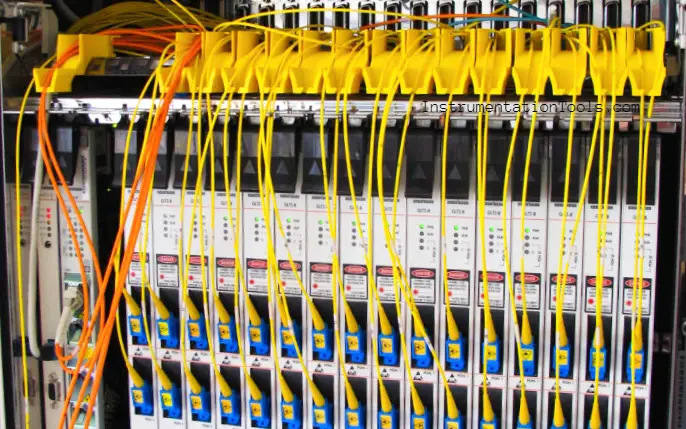Optical fiber is one of the fastest and longest modes of data communication used in networking. It can transmit and receive data at several hundreds of kilometers without loss.
Basically, Optical fiber converts electrical energy into light energy from the transmitter and back to its original form in the receiver. It is due to the light that it works at a lightning-fast speed.
In optical fiber technology, one of the most widely used devices is an optical line terminal, also called OLT. In this post, we will learn the concept of an OLT.

Before we jump into its understanding, let us first clear the basics. An optical fiber network is categorized into two types – active optical network (AON) and passive optical network (PON).
In AON, an optical fiber cable is connected directly to the end device, like a home or office. The data is not distributed anywhere else. But, in PON, splitters are used to distribute the signals from a single point to multiple destinations. This network is necessary to be understood as it is used nowadays more for FTTH (fiber to the home) markets widely.
Due to high-speed data requirements in very less time, FTTH is increasingly used in many areas of application. AON thus connects directly from the distributor to the end customer, whereas PON connects to multiple users by using a single fiber. So, if you look at the cost, PON though having some demerits (lower bandwidth, lower security due to multiple users, and less flexibility); it is then too widely used for many applications.
Now, in a PON network, one of the most common devices you will find is an optical line terminal. There are many PON networks in a large distribution system. Each PON network can connect up to 32 individual lines. An optical line terminal is a device that can connect to up to 4 such PON networks at a time.
The service provider will have an electrical signal from its final equipment, to be distributed to the end customers. But as the customers are not necessarily nearby, it will be required to be converted into an optical signal for a larger distribution range.
This task is done by an optical line terminal. It will convert the electrical signal into an optical signal, and then connect to individual PON networks or a total of 128 lines. So, it is an important gateway device for connecting service providers to individual user nodes.
An Optical Line Terminal (OLT) consists of the following components – CPU, power supply, fan unit, service frame, and other uplink boards. Data is received at its input in electrical form, which converts it into an optical signal and transfers data through optical fiber cables to the splitters or PON network heads.
OLT has two main types of data tasks – downstream (getting data from a global network) and upstream (getting data from users). OLT supports dynamic routing protocols like RIP (routing information protocol) and SPF (small form factor pluggable), ensuring a secure network. It is thus used for many common applications like Wi-Fi, CATV (community antenna television), and security management. An OLT can work at a maximum distance of 20 km.
In this way, we saw the concept of an optical line terminal.
If you liked this article, then please subscribe to our YouTube Channel for Electrical, Electronics, Instrumentation, PLC, and SCADA video tutorials.
You can also follow us on Facebook and Twitter to receive daily updates.
Read Next:
A Real-Time Clock accurately tracks time from seconds to years and stores the data in…
Omron PLC logic for sorting the number of products and counting the number of products…
Learn the water fountain control logic using the PLC timers programming to control the high…
Open Telemetry is a framework for collecting data in cloud-native applications including tracing, metrics, and…
This article is about controlling the Pneumatic cylinder and Pneumatic motor in the assembly line…
In this post, we will learn the basic requirements for a network switch to be…
View Comments
thanks to this platform, it is very helpful l learn a lot and your information are recise and precise